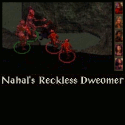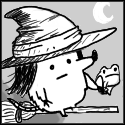|
kingcom posted:I've literally never heard of dry-erase maps outside of wargames. If they are literally so ubiquitous with gaming and so utterly necessary to play any recent edition of D&D. Why are they not sold with D&D products? The 3e box comes with a battle mat in the DMG, and there's a recommendation somewhere in the rulebooks that you have it laminated so you can draw poo poo on it. We did that because it was nicer than our old whiteboard, but the edges kept rolling up so we went back the the whiteboard. Every game store I've ever been in has a section with gridded dry-erase boards or mats, or a few sets of dungeon tiles. This is since 1988. They're right there where you buy the game books. Edit: Yeah, the differences are interesting, but in every edition except Basic and 2e, if you're not playing on a grid (well, in AD&D you can play "gridless" by drawing a map and measuring distance with a wargame ruler), you're not playing rules-as-written. Elector_Nerdlingen fucked around with this message at 04:11 on Apr 23, 2013 |
|
|
|

|
| # ? May 12, 2024 22:18 |
|
Don't think I've ever been at a planned session of D&D without something. Here's a giant old school graph paper pad that our DM busted out last week. (and an awesome Temple of Teleportation 
|
|
|
kingcom posted:Thanks for the link!
|
|
|
|
|
ImpactVector posted:Just another option: I didn't find the link right away when I was searching earlier, but if you wanted to go cheaper I think people have had good luck with this one. I've only ever used the Chessex mats though. I clicked on that link hoping for a map made cheese I would love to have someone show me a game of what they love about 4e though. I get that a lot of people like it but I don't really have a clue as to how to go about running a game around combat. And getting a bunch of other people to play it with me. Also designing combat encounters in the system...
|
|
|
|
kingcom posted:I clicked on that link hoping for a map made cheese The LP forum has a thread with a huge freaking 4E LP that's probably a good showing. There's always the Penny Arcade stuff too.
|
|
|
|
kingcom posted:I clicked on that link hoping for a map made cheese I think the main difference between 4E and other editions in terms of combat encounters is that literally every enemy is unique and does something interesting. In most of the other editions, in terms of what a player sees an orc and a hobgoblin play out exactly the same - the DM might play them differently or have different equipment, but their numbers and abilities are almost exactly the same. Whereas in 4E, orcs and hobgoblins have different racial abilities and each individual type of orc/hobgoblin has their own unique abilities that you can clearly see in play.
|
|
|
|
goldjas posted:The LP forum has a thread with a huge freaking 4E LP that's probably a good showing. There's always the Penny Arcade stuff too. Yea but I don't really get much from second hand accounts unless they are kinda spectacular. I'll have a listen to the Penny Arcade stuff though. Piell posted:I think the main difference between 4E and other editions in terms of combat encounters is that literally every enemy is unique and does something interesting. In most of the other editions, in terms of what a player sees an orc and a hobgoblin play out exactly the same - the DM might play them differently or have different equipment, but their numbers and abilities are almost exactly the same. Whereas in 4E, orcs and hobgoblins have different racial abilities and each individual type of orc/hobgoblin has their own unique abilities that you can clearly see in play. I dont understand how thats a 4e thing? Is it not expected that there are tons upon tons of custom monsters/abilities etc running through any game? kingcom fucked around with this message at 04:51 on Apr 23, 2013 |
|
|
|
kingcom posted:I clicked on that link hoping for a map made cheese 4e isn't any more "designed around combat" than any other edition. The only thing I can think of is that there aren't as many spells that do one specific noncombat thing. Those are still present as Rituals, but there are less of them. Designing combat encounters is easy as hell in 4e, too - there's a rules section dedicated to it and (more than any other edition) if you use the budgeting system you'll come up with a fair encounter (and of course you can change this easily to make an "easy" or "hard" encounter depending on how well your players are doing!) What I mean is, a novice DM in 4e is much less likely to accidentally make a fight too easy or too hard. You can do it on purpose if you want, and the rules describe how to do it. To DM 4e and make it feel like the sort of game your group likes, perform the following steps: 1: Read rulebooks. 2: Write the sort of adventure you like, following the advice in the rulebooks about building encounters and non-combat situations. 3: Play as you normally would, paying close attention to the rulebooks for the first few sessions. In other words, the same as changing from any edition to any other, or from any system to any other. If you find that once you're familiar with the rules, you really don't like it, just don't play it again. Or alternatively do what gamers always do and start houseruling things. I'd start with the skill challenge system, it's easily my least favorite 4e thing. kingcom posted:I dont understand how thats a 4e thing? Is it not expected that there are tons upon tons of custom monsters/abilities etc running through any game? Have you read the 4e rulebooks? I'm not being a dick here, it just sounds like you've never actually looked at the game and are relying on second or third hand accounts. Take the Kobold and Goblin. In 3e, it's not much different from the Goblin. Some of the numbers change, but they're both small humanoids who like to attack with numbers on their side, and favor ambushes and dirty tricks. The book says that, but there's not actually much to the monsters beyond statblocks, which are both pretty similar. In 4e, the Kobold plays differently from the Goblin. The very basic minions of each race have different abilities, not just different numbers, and the differences become more pronounced with the different versions of each monster (ie, goblins get better ranged guys, kobolds get better melee guys). It's not that the kobolds have +1 damage with swords and the goblins have +1 damage with spears, they each get abilities that make them good at their thing (ie, the goblins don't lose "hiding" if they miss a ranged attack from hiding, and the kobolds can shift 1 square if you become/leave adjacent with them) So fighting Kobolds is different from fighting goblins is different from fighting orcs is different from fighting hobgoblins. Not because of some nebulous text "these guys are sneaky and mob up, those guys mob up and are sneaky, these guys are an barbarian warrior race, those guys are a race of warrior barbarians", but because each race has its own different abilities that separate it from the other races. Elector_Nerdlingen fucked around with this message at 05:22 on Apr 23, 2013 |
|
|
|
Gah I cant seem to say anything without setting someone off can I. All I meant was I dont know how to run systems until I play them, I dont learn through just reading, I learn through doing, thats all I meant sheesh. EDIT: My only reference to combat game is that I've never run a game where I'm supposed to set up specific combat encounters, I've only run games where they simply happen as a result of the game/narrative/etc Im sure I saw somewhere that it said your supposed to present x number of encounters or something like that. kingcom fucked around with this message at 05:13 on Apr 23, 2013 |
|
|
|
ritorix posted:Here's a giant old school graph paper pad that our DM busted out last week. That's a 27 x 34 easelpad. It's a great size for making little dungeon levels or pre-designing a couple of skirmishes. I buy mine at Officemax, but I'm sure other office stores would carry similar products.
|
|
|
|
kingcom posted:I dont understand how thats a 4e thing? Is it not expected that there are tons upon tons of custom monsters/abilities etc running through any game? Most of signature 4e stuff was evident in play and didn't really shine through in a casual read of the rules. Consider if you had two Magic cards. One reads "Draw a card, then discard two cards" and the other reads "Discard two cards, then draw a card." Unless you'd played a few games of MtG, they'd seem similar. Consider something like like dwarves' ability to second wind as a minor action*. Everyone else can do it as a standard. On a page, that just looks samey and not very special. "Oh dwarves can do this thing that everybody else can. I guess everybody's the same in 4e now." But it's a big difference. There's a ton of mechanical interactions and whole-picture planning that just didn't exist before or (presumably) after it. *(oh god it's been forever this example may be very wrong) This conversation really belongs in the 4e thread though. Talk to those guys, they can explain it better. But to bring it more on-point, that's what's extremely missing in Next: Big-picture planning. None of it's being designed with an eye towards what does this rule mean for the game as a whole, or with any consideration of how it affects other rules. I mean, consider Facing. It's suddenly important to know where your character's face is pointing. How are you going to track this? With a miniature that has a face you can point at things? Hell no, that doesn't feel like D&D! Everybody's going to declare what they're looking at and the DM is going to remember it. Or, you know, everybody just agrees to forget about that rule like they did spell components and encumbrance. Unless it's really important, then we spend 23 minutes looking it up across four books (and errata) while everybody looks at smartphones or talks about something they saw on TV. Then the DM realizes he's lost the group, makes an ad-hoc ruling (and an empty promise to look it up later), and now it's someone else's turn. gently caress! Mearls did find the "feel" of D&D after all.
|
|
|
|
moths posted:Most of signature 4e stuff was evident in play and didn't really shine through in a casual read of the rules. I didn't understand the difference so I guess thats a perfect example. I wondered into the 4e thread and people got mad at me so I've kinda stayed away from it. Your right though I'll stop derailing.
|
|
|
|
DalaranJ posted:That's a 27 x 34 easelpad. It's a great size for making little dungeon levels or pre-designing a couple of skirmishes. I buy mine at Officemax, but I'm sure other office stores would carry similar products. I've had my big one since early 3e, and can't live without it. I'm kind of surprised not everyone has one.
|
|
|
|
ImpactVector posted:Yup. Works great, though you need to be careful what markers you use on it. That's a wet-erase mat, not a dry-erase. The usage instructions specifically say not to use dry-erase markers I believe. As far as I know, all roll-up battle mats are wet-erase only. Of course, I've only seen Chessex mats in the groups I've played with, so many there's other brands out there that I haven't seen.
|
|
|
|
kingcom posted:I dont understand how thats a 4e thing? Is it not expected that there are tons upon tons of custom monsters/abilities etc running through any game? Here, let me be the diplomat ;p 4e uses a lot of mechanical - fluff meshing together. That is to say, the mechanics cause the game to work in a way that supports the fluff. Kobold throughout D&D have been described as shifty, cunning, hard to nail down buggers who slip through your fingers every dang time you try to attack them to lead you into corridors filled with traps. Mechanically...they were a slightly weaker goblin. But in 4e, ALL KOBOLDS have the ability to shift one square (move five feet without any interference) as a minor action (allowing them to still use both their standard/"attack" option AND their move action), which means mechanically speaking kobolds are constantly slipping here and there in a fight, never letting you pin them down, always running under your legs to shank you in the back or scrambling from your warrior to run away. All major races in 4e, both PC and NPC, have these racial abilities. Orcs bulk up and become way more dangerous when they're bloodied (hit half health), which means when you fight orcs, you DO NOT want to go half way - the more damage you to do orcs, the more you just piss them off. It also means orcs are actually mechanically encouraged to let themselves get beat up a bit before they really unload on you, which can lead to stuff like orcs intentionally throwing themselves bodily at you, consequences be damned, in proper true berserker fashion. It's a purely mechanical thing, but it's one that encourages the fluff of hyper-aggressive orcs. It's a major difference and benefit over "orcs are super aggressive, bloodthirsty, and fly into a rage when they fight, so they're going to have +2 strength and -2 intelligence." On the note of dwarves, Second Wind essentially lets you spend a healing surge (AKA heal), and boosts your defenses for that turn. Normally it takes your standard action - that is to say, that's the MAJORITY of your turn. It represents your character backing away, collecting themselves, calming their butt down, and focusing a bit inward. It's that scene from every action movie where the protagonist pauses to catch their breath. Dwarves, on the other hand, do it as a minor - which means their "Do a thing" action is still available. This translates into dwarves being incredibly, incredibly tough. Even if you beat the poo poo out of a dwarf, he's going to narrow his eyes, focus his strength, and continue pushing you back. Not only that, but the dwarf is actively fighting back even as he collects himself. Again, this is a big step forward from "Dwarves are tough and relentless and never go down without a fight, so they have +2 constitution." Dwarves are tough (gain their health back), relentless (+2 defenses), and never go down without a fight (uniquely can do this and STILL put an axe in your face). ( Also do we even have a 4e thread? )
|
|
|
|
ProfessorCirno posted:( Also do we even have a 4e thread? )
|
|
|
|
kingcom posted:I clicked on that link hoping for a map made cheese Aside from the stuff already mentioned I'm a fan of Nerd Poker over at Ear Wolf. What drew me to it was that Brian Posehn just roped his regular group instead of pulling random celebrities or Wizards reps. It's an older AD&D era group figuring out 4e as they go and breaking to share role-playing stories. Plus Posehn plays a botched Intimidate church by whimpering "I'll hurt you with my tears." Also, someone needs to tell Mearls that calling every rule an optional module doesn't make it okay to do poo poo work. If I sold cars I couldn't mark 3d gear as an optional feature if it blew the tranny every time you shifted into it. That's not how design works.
|
|
|
|
moths posted:But to bring it more on-point, that's what's extremely missing in Next: Big-picture planning. None of it's being designed with an eye towards what does this rule mean for the game as a whole, or with any consideration of how it affects other rules. ProfessorCirno posted:(Awesome explanation) It's an absolutely genius mechanic, but coming up with it and making it work required the developers to be aware of multiple aspects of the game simultaneously (character hit points, average monster damage, amount of healing per encounter, potential encounters per day, between-fight recovery, etc) and adjust them accordingly. And I'm not entirely sure Next's staff is capable of this sort of metagame design.
|
|
|
|
ProfessorCirno posted:Here, let me be the diplomat ;p Diplomat? I'm not trying to be some edition war guy, I've honestly played very little D&D period. I'm asking these questions because im genuinely ignorant of the game. Honestly D&D is the first game ive played where there are heaps of books that are just about giving you stats and rules for monsters rather than them being very much a minor/side thing or used only as an example. Its a whole new concept to me. Stuff like building a combat encounter is not something I've done. I'm still not seeing the revolutionary thing popping up, it just seems like your creating monsters and creating appropriate rules to use them well. Is that just a big step over on 3rd or? Sorry, maybe I just need to see it in action. This seems to be something that exists in a lot of games but maybe im just seeing it after the fact. kingcom fucked around with this message at 09:34 on Apr 23, 2013 |
|
|
|
The biggest illustration that Next's design is taking a scattershot "throw poo poo at the wall and do it by feel" approach is the XP charts. I'm just gonna quote:quote:I've not sat down and looked at the maths of 5e so could someone explain to me what is notably bad about it for the current iteration of the playtest rules. quote:Here's a really basic one: there's an xp table, that determines when characters get to a new level. And there's also an encounter building table, that tells us how much xp an average encounter is worth. Put them both together, and you can see about how many encounters a party will go through in order to gain a new level. This is both really easy to do, and a major factor in driving playstyle, so it's the kind of thing you'd expect them to be keeping a close eye on. Working out advancement rate based on xp per encounter was one of the main tenets of 3e, and is similarly important in 4e. Comments by Mearls and Rodney on advancement rate tell us it's something the 5e team would like to nail, too - leveling every other session after the apprentice tier, for example. And working this out is simple arithmetic, nothing more complicated than long division, so the only way to screw it up is basically not to do it in the first place.
|
|
|
|
kingcom posted:Diplomat? I'm not trying to be some edition war guy, I've honestly played very little D&D period. I'm asking these questions because im genuinely ignorant of the game. Honestly D&D is the first game ive played where there are heaps of books that are just about giving you stats and rules for monsters rather than them being very much a minor/side thing or used only as an example. Its a whole new concept to me. Stuff like building a combat encounter is not something I've done. I'm still not seeing the revolutionary thing popping up, it just seems like your creating monsters and creating appropriate rules to use them well. Is that just a big step over on 3rd or? quote:Sorry, maybe I just need to see it in action. This seems to be something that exists in a lot of games but maybe im just seeing it after the fact. Kai Tave posted:The biggest illustration that Next's design is taking a scattershot "throw poo poo at the wall and do it by feel" approach is the XP charts. I'm just gonna quote:
|
|
|
|
Asimo posted:To add a little more context to Cirno's statement, for the most part 3e's monsters were defined by things like their attributes, hit points, and damage dice, or for really strong ones, the spells (or spell-like abilities) they used. This made for very large and varied statblocks... that in practice still basically boiled down to "monster rolls to hit, rolls dice if it hits" or "monster casts one of a spell, all monsters that use that spell do the same thing". Their Charisma or the fact they used an axe instead of a sword didn't really matter 90% of the time. Contrast that to what Cirno explained, where 4e monsters had a handful of abilities, but all generally unique and which played into their particular concept or niche. It lead to both shorter statblocks and ones that were more fun to use in play. Wait...what. Are you saying 3e monsters literally were nothing more than stat blocks and to hit numbers?
|
|
|
|
kingcom posted:Theres no grid your tracking simply distance form players to enemy. kingcom posted:Diplomat? I'm not trying to be some edition war guy, I've honestly played very little D&D period.
|
|
|
|
kingcom posted:Wait...what. Are you saying 3e monsters literally were nothing more than stat blocks and to hit numbers? They had spot and notice skill ranks too.
|
|
|
|
Kobold Goblin Show me a meaningful difference between the two. One that will actually affect play. Sure there's a lot of different numbers there, but do any of them actually matter?
|
|
|
|
kingcom posted:Wait...what. Are you saying 3e monsters literally were nothing more than stat blocks and to hit numbers? For humanoid-type monsters, yes. By and large they either had no unique abilities (at least that would be visible from a player's POV), or were just spellcasters barely different from a human wizard. Take, for example, hobgoblins vs orcs, or gnolls vs lizardfolk. There's no real difference between them other than gear. Even powerful monsters like the Pit Fiend don't have anything really interesting to do, it's just a monster with a bunch of resistances/immunities and some spells. Look at the tactics list, for god's sake - it's either casting spells that any player wizard fighting it could also cast, or it's just full attacking like any player fighter could be doing at that level. The disappointing thing about Next is that it's returning to this boringness. There's nothing that distinguishes an orc from a hobgoblin other than their gear.
|
|
|
|
kingcom posted:Diplomat? I'm not trying to be some edition war guy, I've honestly played very little D&D period. I'm asking these questions because im genuinely ignorant of the game. Honestly D&D is the first game ive played where there are heaps of books that are just about giving you stats and rules for monsters rather than them being very much a minor/side thing or used only as an example. Its a whole new concept to me. Stuff like building a combat encounter is not something I've done. I'm still not seeing the revolutionary thing popping up, it just seems like your creating monsters and creating appropriate rules to use them well. Is that just a big step over on 3rd or? I don't mean diplomat in any edition war sort of way, more that I was hopefully explaining it in a (relatively) simple way that made sense 
|
|
|
|
Splicer posted:Kobold ..and now I'll show my ignorance of online RPG stuff by asking if there's a similar site for 4e. I'm guessing not, but it'd be cool to compare the two side-by-side without getting my books out for the 2nd time today.
|
|
|
|
Asimo posted:Of course not. OH I understand now, I was just assuming that making different monsters different was something that was so obvious every game did it. I was wrong 
|
|
|
|
kingcom posted:Wait...what. Are you saying 3e monsters literally were nothing more than stat blocks and to hit numbers? 2e Monster manuals had a lot more fluff (not really familiar with before that), like how many offspring monsters would have, and their favorite foods. 3e and 4e focused a lot more on combat abilities and tactics. I liked liked the fluff part for idea generation and kinda wish they put it back, but a lot of people largely ignored it because it was weirdly specific. I mean does it matter that a roc nest has a 15% change to have 1d4+1 eggs, and if it comes up, does it matter if the DM just say 3 - is he really going to roll for it?
|
|
|
|
Fluff is neat, but a treatise on the ecology of the kobold isn't the only way to go about it. 4E tries to differentiate monsters and enemies through the actions and abilities they have which, taken together, tend to say something about the sorts of monsters they are. Kobolds get to shift all over the place like slippery little bastards...so kobolds are probably slippery little bastards. Orcs get angry the more they get hit and even get a free attack when you put them at 0 hitpoints, so that gives you a good idea of what the average orc is like. Divorce those statblocks from the name...like, present a 4E orc statblock without showing someone it says "Orc" at the top...and the mechanics still convey something about the sort of creature it's meant to be (gets angry when it takes damage, gets one last spiteful attack when you put it down because gently caress you, that's why). Strip the names from the statblocks of 3.X monsters and it's a lot more difficult to get a feel for exactly what sort of creature or monster those numbers are meant to represent. The fluff is that kobolds are cowardly but cunning trapmakers and skirmishers...which is represented by 2 ranks in Craft: Trap and an extra rank in Hide compared to goblins. And they use spears and slings instead of morningstars and javelins. There are other differences...kobolds are lawful evil for some reason while goblins are neutral evil, goblins have a point higher in Fortitude...but these differences are A). pretty minor and B). not at all that noticeable to players in actual play when it comes time to throw down with a band of kobolds versus a band of goblins, the two creatures are pretty much going to feel identical to fight against...they're small, runty trash enemies and the fact that one is using spears and the other uses morningstars or that one has 2 skill ranks in a Craft skill that it will never actually employ in any meaningful sense is going to be completely lost on most people.
|
|
|
|
Kai Tave posted:The biggest illustration that Next's design is taking a scattershot "throw poo poo at the wall and do it by feel" approach is the XP charts. I'm just gonna quote: Wow that's depressing. I feel like older versions of D&D were designed in some fashion. Maybe it wasn't always good design and frequently it was some kind of exponentially complex iterative design thought process but there was some kind of thought process behind it. I feel like Next is the first game designed to have mechanical wonkiness in it on purpose. Like trying to design a happy accident.
|
|
|
|
gninjagnome posted:2e Monster manuals had a lot more fluff (not really familiar with before that), like how many offspring monsters would have, and their favorite foods. 3e and 4e focused a lot more on combat abilities and tactics. I liked liked the fluff part for idea generation and kinda wish they put it back, but a lot of people largely ignored it because it was weirdly specific. I mean does it matter that a roc nest has a 15% change to have 1d4+1 eggs, and if it comes up, does it matter if the DM just say 3 - is he really going to roll for it? The 2e fluff/ecology stuff was more or less copy/pasted from 1e. There was some re-wording here and there, and some things might have had 1d8 whatevers of thing instead of 1d6 thingies of whatever, but it's essentially the same stuff.
|
|
|
|
kingcom posted:OH I understand now, I was just assuming that making different monsters different was something that was so obvious every game did it. I was wrong So does 4E have long, involved combat? Compared to, say, FATE, or *world system, yes. Compared to 3.x? You'll get more done in less time with more fun. Do you need a grid? Compared to the Cortex system or WFRP3, yup. Compared to 3.x? Playing 3.x without gridded combat is like buying a Ferrari and never going above 50, playing 4E without gridded combat is like buying that car from Speed Racer and only using it to go shopping *Standard Disclaimer: 3.X contained many innovations that the hobby today would be poorer without. 3.X was amazing, for its time. That time was almost thirteen years ago, not including some things that were holdovers from 2E, which itself was over a decade old at 3E's release. Some of the experimentation has stood the test of time (unified resolution system), some have not (NPCs constructed like PCs). So yeah, a lot of the things we're saying are good about 4E may seem fairly obvious, but compared to 3.x they're nothing short of revolutionary. The reason Next is looking so worrying is because while AD&D, 2E, 3E/3.5, and 4E all tried to move forward, the only reason I'm not saying that Next is deliberately regressing is because that unfairly implies that there was a time when the Next design process wouldn't have been viewed as a horrible travesty of proper game construction. e: If you don't like running gridded combat neither 3.X or 4E are really the game for you. We will happily suggest a number of games that do what you want way better than either! Splicer fucked around with this message at 13:01 on Apr 23, 2013 |
|
|
|
Splicer posted:A lot of the stuff being said about 4E is in comparison to 3.x. 4E is an overall pretty good game with some very good aspects, with the vast majority of its bad parts being holdovers from 3.x. If you're approaching it from a non-D&D perspective it has a number of glaring flaws and does a lot of stuff that other games have done before, and in some cases better. What 4E has over not-D&D can be boiled down to having the best tactical combat on the market and way, way more support than any other publisher could hope to come near. It's also worth noting that as a fan of 4e, the game has serious problems. 4e, I mean. It's a great game but it has huge flaws. It isn't perfect. One of the reasons you see people fight about it so much is that it always feels like we're arguing about the wrong stuff. Virtually anyone who likes 4e will admit the Skill system is sorta borked and needs a lot of finessing, the game has way too much Feat bloat, there are serious problems with early monsters and on and on. Next could have learned from those lessons and improved upon those issues, but instead it chose to address the fake ghost problems that never really existed in the first place. Going back on those "problems" (no healing surges, no martial healing, no marking) because of the same tired fallacies is really disheartening. e: I mean to be fair if someone tells me, "I don't like marking" or whatever, that's fine. I don't care. People can not like things. The issue is that we're given these post-hoc rationalizations about the mechanics as if they're all grounded in reality. Oh course you can't shout a person back from the dead, so that's right out! Because narrative disconnect and because Mendrian fucked around with this message at 13:06 on Apr 23, 2013 |
|
|
|
4E is a game, in my opinion, whose successes are pulled off so well that they manage to generally overcome the flaws present within it. That's not saying that what it does right excuses those flaws or makes them less flawed, but that its successes are solid enough and the flaws thankfully not crippling enough that it (usually) rises above them. I'll be honest, I'm actually kind of surprised/impressed that 4E works as well as it does. Coming off of 3.X I can see so many ways where the execution of 4E could have suffered, where things could have broken down and turned into poo poo, and the fact that it didn't even after 4.5/5 years worth of stuff is genuinely kind of amazing. But it could still use revisions and fixes and streamlining and new ideas applied to it, it's far from some perfect game.
|
|
|
|
Mendrian posted:It's also worth noting that as a fan of 4e, the game has serious problems. 4e, I mean. It's a great game but it has huge flaws. It isn't perfect. One of the reasons you see people fight about it so much is that it always feels like we're arguing about the wrong stuff. Virtually anyone who likes 4e will admit the Skill system is sorta borked and needs a lot of finessing, the game has way too much Feat bloat, there are serious problems with early monsters and on and on. Next could have learned from those lessons and improved upon those issues, but instead it chose to address the fake ghost problems that never really existed in the first place. Going back on those "problems" (no healing surges, no martial healing, no marking) because of the same tired fallacies is really disheartening. But because I'm capable of analysing things critically I also recognise that parts of it could be done better, and that parts of it are complete tripe. I recognise that a number of its goals could be done using completely different methods. I love 4E because they took 3.X, stripped out a lot of the stuff that didn't work, pumped the stuff that did, streamlined stuff that was too bloated etc etc. Is 4E perfect? Of course not! But it's still the best D&D-style game out there at the moment. Is it the best game out there? Nope (that would be Owlbears) but if you wanted to play a dude with a giant axe smashing the crap out of some orcs and taking their stuff, D&D 3.x was your go-to in the early 00s, and 4E improved upon it. So when I (and a lot of 4E fans) say we don't like the direction Next is taking it's not knee-jerk reaction to change. If that was the case I'd be playing Pathfinder. I don't like the direction Next is going because it's awful.
|
|
|
|
About the 4E battles taking too long argument, it has to be mentioned that they take too long compared to low level 3E battles. By level 10 not only do the (caster) players have a shitload of options, but same goes for monsters with spells and spell-like abilities. I can't count how many times we were about to start whooping some demon butt, and the DM went "hold on a moment, this fucker has a million spells, pass me the PH and role-play by yourselves for a while"
|
|
|
|
Splicer posted:e: If you don't like running gridded combat neither 3.X or 4E are really the game for you. We will happily suggest a number of games that do what you want way better than either! Heres why I started paying attention to Next, I never gave 4th a thought because I was told it required a grid, everyone here seems to support that. The big push at the start of Next's announcement was that it didn't require a grid and would be open to new players to get in. Hence my paying attention to it. Splicer posted:A lot of the stuff being said about 4E is in comparison to 3.x. 4E is an overall pretty good game with some very good aspects, with the vast majority of its bad parts being holdovers from 3.x. If you're approaching it from a non-D&D perspective it has a number of glaring flaws and does a lot of stuff that other games have done before, and in some cases better. What 4E has over not-D&D can be boiled down to having the best tactical combat on the market and way, way more support than any other publisher could hope to come near. As somebody who has no connection to any of this stuff, Next looks boring. So messy to deal with pretty simple stuff and everything seems to take a long time to resolve. I'm not sure how half the classes distinguish themselves outside of combat exactly. Also, I've been playing in a Pathfinder game recently and been having no problem without grids. Though I accept your warning, even if it is dropping much of the game its not a problem as im thinking that part of the game doesn't interest me in the first place. The thing about D&D is that its one of those games that everyone seems to play, so regardless of the game you WANT to play, it ends up being played because either thats the only thing people agree on or can accept enough to play. I honestly wouldn't be too bothered if this crashed and burned and let a group of other RPGs take center stage for a while. EDIT: I don't see that happening though, I feel the name itself is enough to project it forward regardless of how the internet at large is perceiving it. kingcom fucked around with this message at 14:29 on Apr 23, 2013 |
|
|
|

|
| # ? May 12, 2024 22:18 |
|
Rexides posted:About the 4E battles taking too long argument, it has to be mentioned that they take too long compared to low level 3E battles. By level 10 not only do the (caster) players have a shitload of options, but same goes for monsters with spells and spell-like abilities. I can't count how many times we were about to start whooping some demon butt, and the DM went "hold on a moment, this fucker has a million spells, pass me the PH and role-play by yourselves for a while" The last sentence is exactly right. I think that the bigger fallacy involved with that argument against 4th is the simple fact that the snappiness of things is primarily dictated by the DM and their party. In 4th if you're paying attention, actually understand your character and their intricacies, and spend a couple seconds planning your move while someone else goes then the pacing is great. The same thing holds true for a lot of arguments across editions. People just have trouble parsing out what's a symptom of the game system as opposed to a symptom of the game's players.
|
|
|

































